May is bonus month! Following Puzzle #52 below is a bonus puzzle #53 for you to solve.
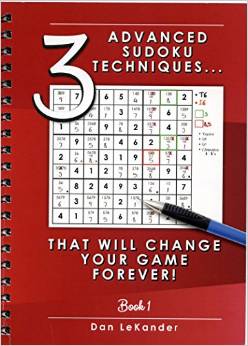
DAN’S 8-STEP APPROACH TO SOLVING ALL SUDOKU PUZZLES
Once you have completed the puzzle, to the extent that you have filled-in all obvious answers and have written all potential options across the top of the unsolved cells (PUZZLE PREPARATION), Dan recommends the following Steps to complete the puzzle.
Step 1: Sudoku Pairs, Triplets and Quads – September 2015
Step 2: Turbos & Interaction – October 2015
Step 3: Sudoku Gordonian Rectangles and Polygons – November 2015
Step 4: XY-Wings & XYZ Wings – December 2015
Step 5: X-Wings – January 2016
________________
Step 6: DAN’S YES/NO CHALLENGE
Step 7: DAN’S CLOSE RELATIONSHIP CHALLENGE
Step 8: AN EXPANSION OF STEP 7
Steps 1-5 are relatively common techniques and are explained in the TI LIFE articles above. Steps 6-8 are covered in detail, in Dan’s book.
Also, see Sudoku Puzzle Challenge… February 2016, March 2016, April 2016, May 2016, June 2016, July 2016, August 2016, September 2016, October 2016, November 2016, December 2016, January 2017, February 2017, March 2017 , April 2017, May 2017, June 2017, July 2017, August 2017, September 2017, October 2017, November 2017 , December 2017, January 2018, February 2018, March 2018, April 2018. May 2018, June 2018, July 2018, August 2018, September 2018 , October 2018, November 2018, December 2018, January 2019, February 2019, March 2019 and April 2019.
As a reminder, the basic rules of Sudoku are that the numbers 1-9 must be contained and cannot be repeated in a row, column, or box, and there can only be one solution to the puzzle.
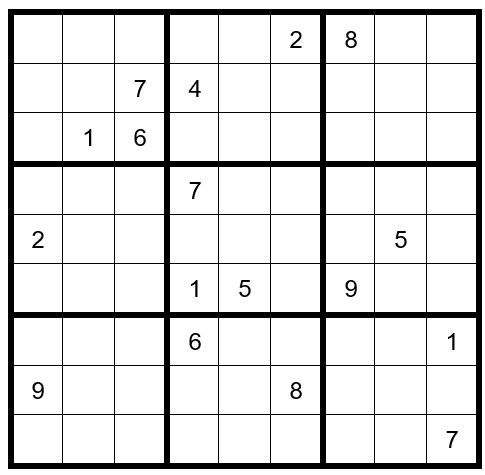
PUZZLE PREPARATION
Prior to utilizing techniques first complete the 4 Steps of Puzzle Preparation …
- FILL IN OBVIOUS ANSWERS
- FILL IN NOT-SO-OBVIOUS ANSWERS
- MARK UNSOLVED CELLS WITH OPTIONS THAT CANNOT EXIST IN THOSE CELLS
- FILL IN THE OPTIONS FOR THE UNSOLVED CELLS
OBVIOUS ANSWERS …
Before we begin let’s see if there are any observations regarding the given answers that might positively affect us later in the puzzle. In box 9 (Lower right-hand box of 9 x 9 cells) we see that options 8 & 9 can exist only in C8R7 (cell in column 8, row 7) and C8R9. So, we will pause here and enter options 89 in those two cells per Example #52.1 below:
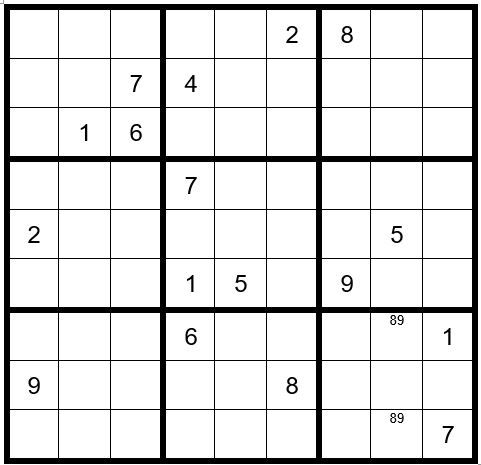
Now start with the 1’s to see if there are any obvious 1-choice answers. Then navigate the 2’s through 9’s.
The first obvious answer is C2R2=2. C5R4=2. Now your grid should look like Example 52.2 below:
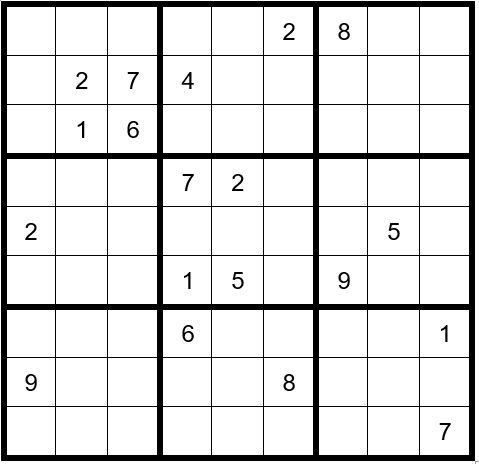
NOT-SO-OBVIOUS ANSWERS … there are none.
MARK UNSOLVED CELLS WITH OPTIONS THAT CANNOT EXIST IN THOSE CELLS …
The only cells in box 5 (center, middle box of 9x9 cells) that can be an 8 are C4R5 or C5R5; therefore, an 8 cannot exist in C2R5, C3R5 or C9R5 (we already know an 8 cannot exist in C7R5). Indicate this by placing a small 8 in the bottom of those three cells, as per example below.
The only cells in box 1 that can be a 9 are C2R1 or C3R1; therefore, a 9 cannot exist in C4R1, C5R1, C8R1 or C9R1.
The only cells in box 1 that can be an 8 are C1R2 or C1R3; therefore, an 8 cannot exist in C1R4, C1R6, C1R7 or C1R9. Now your grid should look like Example #52.3 below:
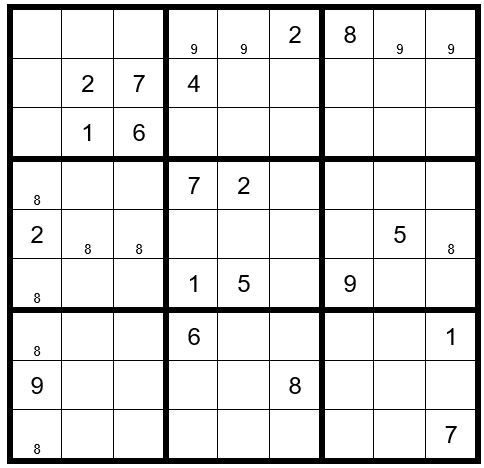
FILL IN THE OPTIONS FOR THE UNSOLVED CELLS …
We will start by filling in the options for the unsolved cells in row 1. C1R1 options are 345, C2R1 are 3459, C3R1 are 3459, and C4R1 are 35. Behold, we have already uncovered an obvious quad … only 4 cells in row 1 can have the 4 options 3,4,5,9; therefore, no other unsolved cells in row 1 may have those options. The remaining unsolved cells in row 1 must have options 167. We already see a 1 and 7 in column 9; therefore C9R1=6. Now C5R1 and C8R1 must have options 17. (HINT … when filling in options for unsolved cells, first do the columns and rows around given cell configurations such as you find in box 1 and 5. Quite often you will uncover a quad or quint, which will ease the burden of completing the puzzle).
Once you fill in the options for the remaining unsolved cells, your grid should look like Example #52.4 below:
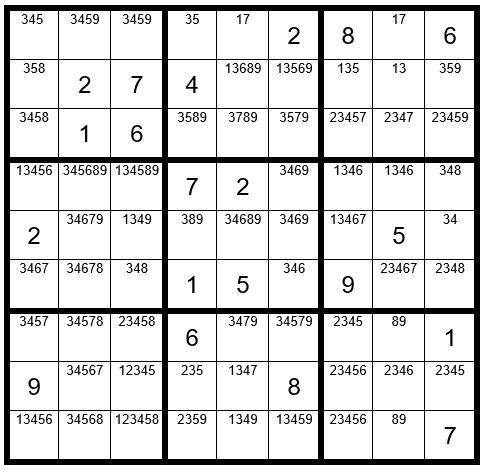
STEPS 1-8
There are no Step 1 – 5 clues, so we will now proceed to Step 6: Dan’s Yes-No Challenge.
There are 3 circumstances that establish the potential for a Step 6 exercise:
- Look for just 2 unsolved cells in a box that contain the same option where these 2 cells are not in the same row or column.
- Look for just 2 unsolved cells in a column that contain the same option where these 2 cells are not in the same box.
- Look for just 2 unsolved cells in a row that contain the same option where these 2 cells are not in the same box.
We will start by searching the 1’s to see if there is a potential Step 6 clue, and then navigate through the 2-9’s.
In column 1 we find just 2 unsolved cells that contain the option 1 … C1R4 & C1R9.
These cells are not in the same box, thereby qualifying as a candidate for a Step 6 exercise. The options in these cells are highlighted in yellow in Example #52.5 below:
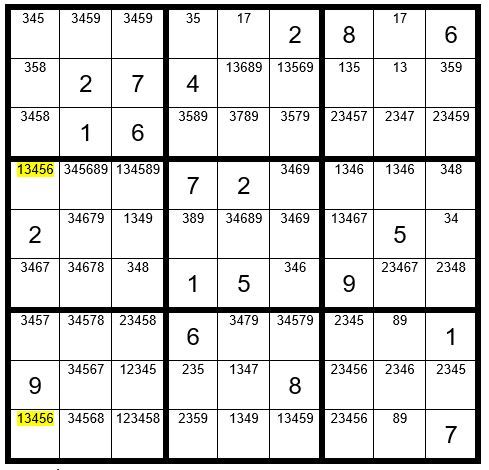
Do you agree that one of these two yellow cells in column 1 must be a 1? We will consider them “driver cells” which “drive” the exercise.
Here is the logic. We will perform two exercises. First, we will assume C1R4 is the 1 and see which other cells cannot be a 1. Then we will assume C1R9 is the 1 and see which other cells cannot be a 1.
We will mark C1R4 with a “Y” and mark C1R9 with a lower case “y” to keep track of the exer-cise as per Example #52.6 below.
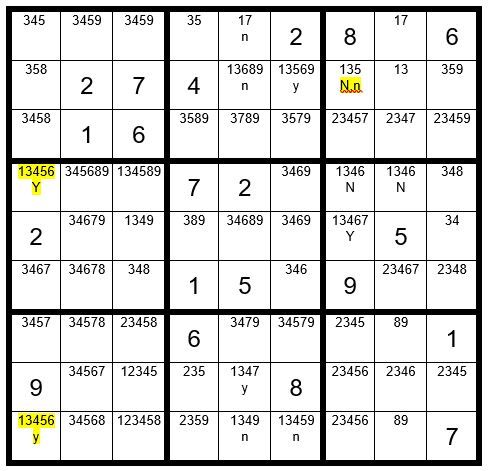
We start by assuming C1R4=1. Then, as marked above, C7R4 & C8R4 are not a 1 (marked with a “N”). Now the only cell in box 6 that can be a 1 is C7R5, so we will mark it as a “Y”. Then, C8R2=N.
Now we will assume C1R9=1 (y for yes). Then, C5R9=n. C6R9=n. C5R8=y. C5R1=n. C5R2=n. C6R2=y. C7R2=n.
We now see in Example #52.6 above that …
• 1 cell has an N,n designation, meaning that it cannot be a 1 regardless of which driver cell is a 1; therefore, you can remove a 1 as an option from C8R2.
• We now have only 2 unsolved cells in box 3 that can be a 1, C8R1 & C8R2. This creates an Interaction eliminating option 1 from C8R4.
Now your grid should look like Example # 52.7 below:
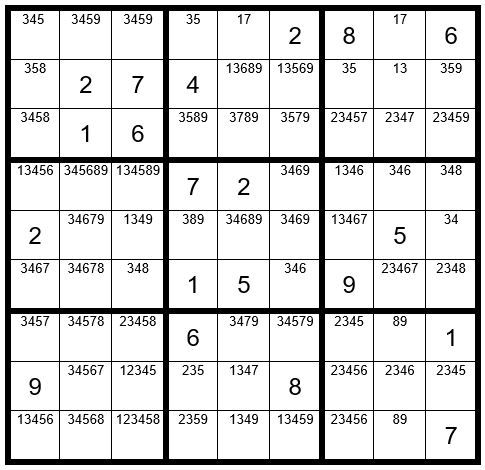
We will continue to search for another Step 6 possibility.
In column 1 we find just 2 unsolved cells that contain the option 7 … C1R6 & C1R7.
These cells are not in the same box, thereby qualifying as a candidate for a Step 6 exercise. The options in these cells are highlighted in yellow in Example #52.8 below:
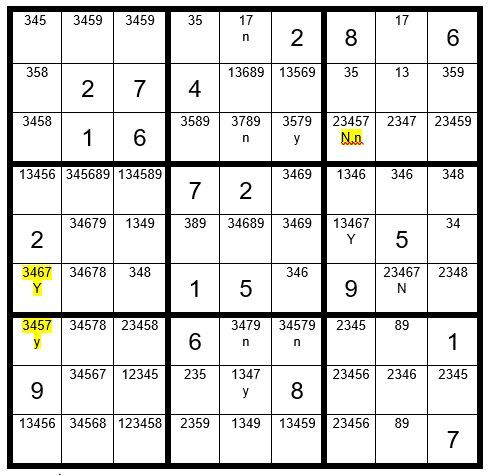
We will mark C1R6 with a “Y” and mark C1R7 with a lower case “y” to keep track of the exer-cise as per Example #52.8 above.
We start by assuming C1R6=7. Then, as marked above, C8R6 is not a 7 (marked with a “N”). Now the only cell in box 6 that can be a 7 is C7R5, so we will mark it as a “Y”. Then, C8R3=N.
Now we will assume C1R7=7 (y for yes). Then, C5R7=n. C6R7=n. C5R8=y. C5R3=n. C5R1=n. Then C6R3 is a y. C7R3=n.
We now see in Example #52.8 above that …
• 1 cell has an N,n designation, meaning that it cannot be a 7 regardless of which driver cell is a 7; therefore, you can remove the 7 as an option from C7R3
• C8R1 & C8R3 form an Interaction, eliminating the 7 as an option for C8R6.
Now your grid should look like Example # 52.9 below:
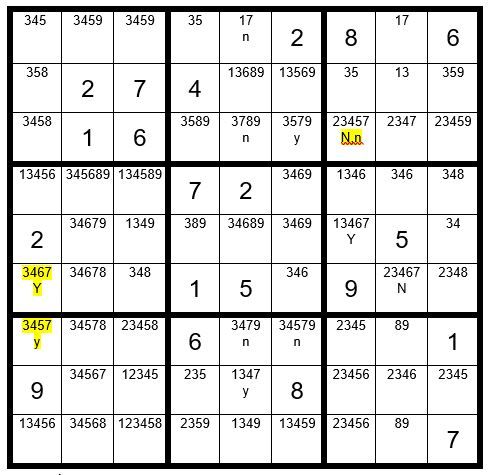
You can now see in Example #52.9 above that C7R5=7. C3R5=1. C1R9=1. C5R8=1. C5R1=7. C8R1=1. C8R2=3. C7R2=5. C9R2=9. From this point the puzzle is easily solved, giving us Ex-ample #52.10 below:
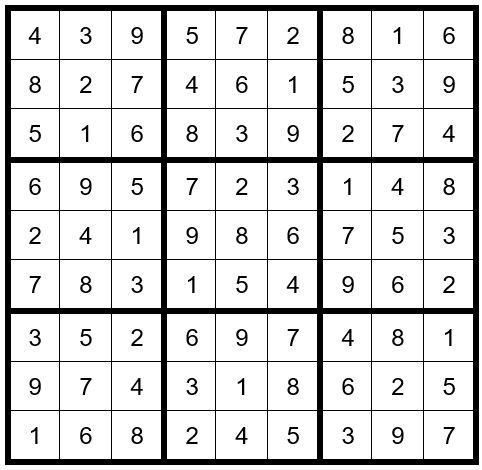
Step 6 again saves the day!
As promised, here is Puzzle #53. Use your Sudoku skills to arrive at the solution. (OK … a couple of hints if you need help are below).
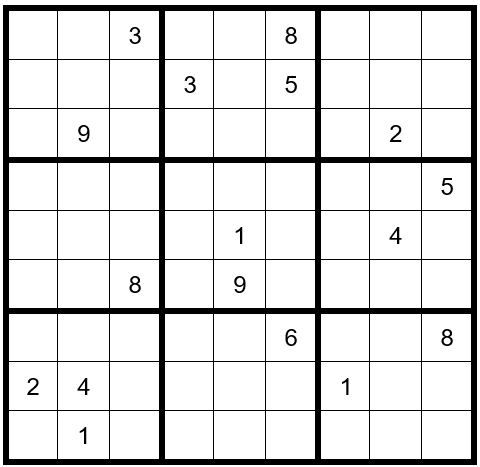
I really like this puzzle. It is a bit tricky, but the puzzle can be solved without using Advanced Techniques 6-8. Watch for Quads & and perhaps a Gordonian Polygon. If you need to review Step 1-5 techniques, please see the reference links at the beginning of this article.
May the gentle winds of Sudoku be at your back,
By Dan LeKander, Wellesley Island
In January 2016, we published a final article in his series – but many of us enjoy using “Dan’s Steps,” so when he asked if we would like a puzzle to solve every month … this editor said an enthusiastic… Yes, please! Now we are several years later and on Puzzle #52 and #53!
I suggest you purchase Dan’s book a “3 Advanced Sudoku Techniques, That Will Change Your Game Forever!” Purchase of a book includes a 50-page blank grid pad, 33 black and two green tokens, to assist with Step 6.…
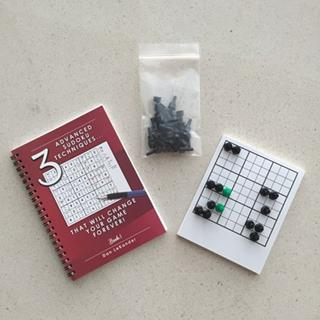
The book is available online, amazon.com and on ebay.com.
Most importantly, I ask that you leave comments on any part of his series and throughout the year.
As always, I want to thank Dan…and his proofreader… Peggy! I am hoping you will enjoy our Sudoku and at the same time join me in thanking Dan - Bravo to you both…
Posted in: Volume 14, Issue 5, May 2019, Sports
Please click here if you are unable to post your comment.
